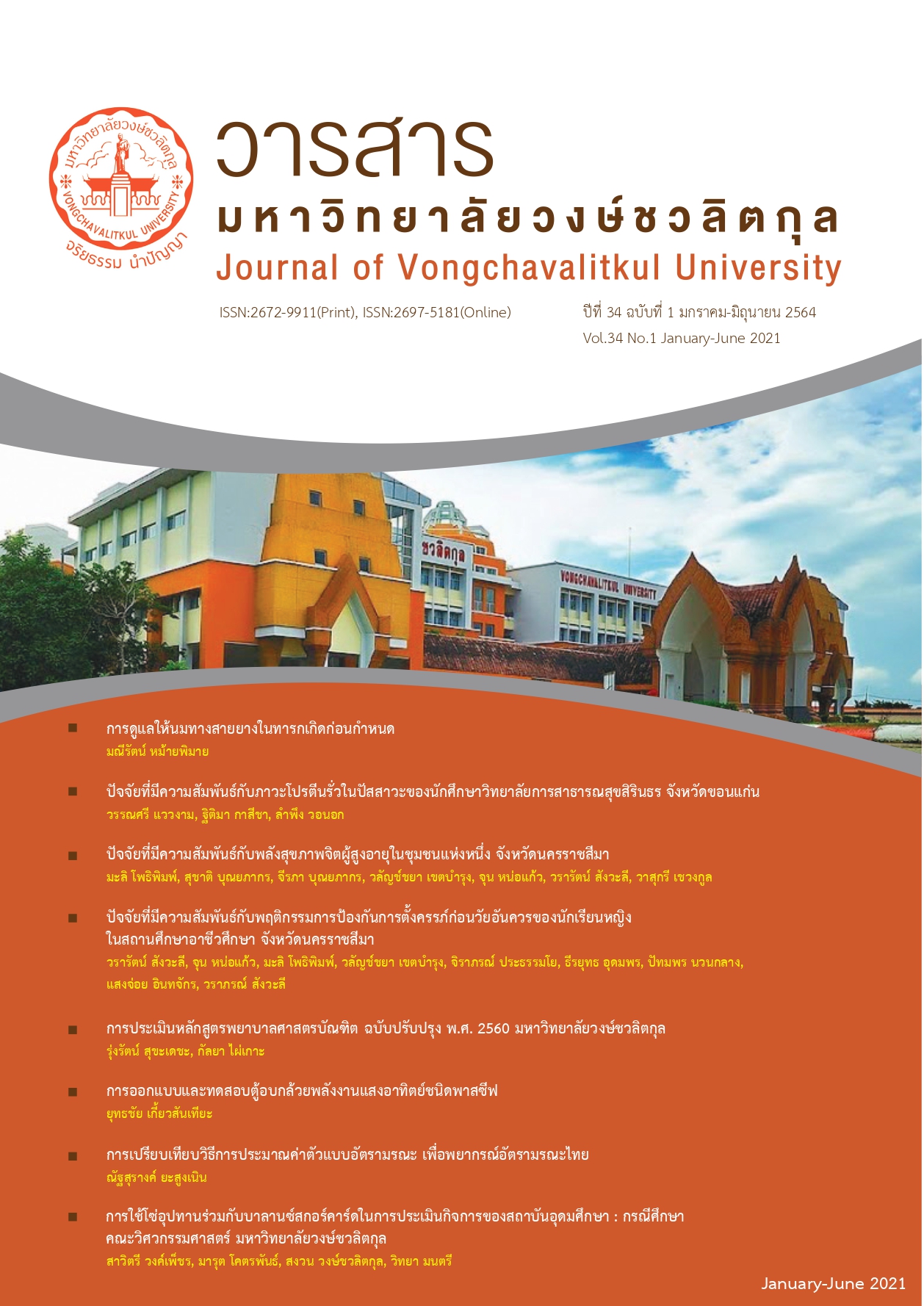Using Supply Chain with Balanced Scorecards in Assessing Tertiary Institution's Affairs : A Case Study of The Faculty of Engineering Vongchavalitkul University
Main Article Content
Abstract
Objective: To study and apply a supply chain in conjunction with a balanced scorecard to evaluate educational affairs. As well as, offering a tool used to improve the management process of the Faculty of Engineering, Vongchavalitkul University.
Methods: The informant group, who involved in the educational administration of the Faculty of Engineering Vongchavalitkul University, consisted of the dean and heads of departments in the total of 6 persons. The data was collected using questionnaires and interviews. The approaches involved studying the current state and writing a diagram of the institutional supply chain and the educational supply chain, analyzing the supply chain in education and assessing educational affairs with a balanced scorecard process, using statistical analysis of collected data to find mean, percentage, weighted value and suggesting the tool for improving the efficiency of educational administration.
Results: From the study of the supply chain structure of higher education institutions, the holistic view of the supply chain education can be summarized as follows: The raw material section consisted of students’ internal and external research projects and the final output consisted of the graduates and the results obtained from the research. The result of the analysis of the effectiveness of each perspective in the educational supply chain of the Faculty of Engineering can be integrated and adapted to suit the university context. Under the balancing scorecard process, the four perspectives consisted of financial aspects (income and expenditure), customer perspective (students / graduates), the internal processes perspective (teaching and learning management) and the perspective of business expansion (the number of new students and new personnel). From the analysis of the balance scorecard concept, the financial perspective was the most important factor and had the greatest impact on the educational administration. The results of this study can be used to assess the educational affairs and to suggest the tool for improving the efficiency of educational administration. This study provides a guideline for solving problems in each activity of the financial perspective. The first solution is Economic Value Management (EVM) which can increase income and reduce expenses or reduce costs. The second solution is Asset Management which can reduce the cost of capital. The last solution is Results Based Management (RBM) which involves letting the executives know the progress of the operation and solving problems in a timely manner.
Article Details
References
2. ทัศน์ศิรินทร์ สว่างบุญ และ บุญชม ศรี สะอาด. (2563). รูปแบบการติดตามตรวจสอบและประเมินผลงานของมหาวิทยาลัยราชภัฏ. วารสารวิจัยราชภัฏพระนคร สาขามนุษยศาสตร์และสังคมศาสตร์, 15(1), 422 – 437.
3. นภดล ร่มโพธิ์. (2545). Balanced Scorecard กับมหาวิทยาลัยในประเทศไทย. วารสารบริหารธุรกิจ, ฉบับที่ 9, 61 – 69.
4. บัณฑิต พุทธโศภิษฐ์. (2557). การพัฒนารูปแบบการบริหารจัดการเทศบาลตำบลสลกบาตร โดยใช้แนวคิดบาลานส์สกอร์การ์ด (Balanced Scorecard). ปริญญาวิศวกรรมศาสตรมหาบัณฑิต, มหาวิทยาลัยเทคโนโลยีสุรนารี. สำนักพิมพ์มหาวิทยาลัยเทคโนโลยีสุรนารี : มหาวิทยาลัยเทคโนโลยีสุรนารี.
5. ปิยวรรณ อยู่พรม. (2550). การปรับปรุงการบริหารการดำเนินงานของโรงพิมพ์โดยการใช้การบริหารเชิงดุลยภาพและแนวทางการบริหารจัดการเพื่อสร้างมูลค่าเชิงเศรษฐศาสตร์ : กรณีศึกษา โรงพิมพ์แห่งจุฬาลงกรณ์มหาวิทยาลัย. ปริญญาวิศวกรรมศาสตรมหาบัณฑิต, จุฬาลงกรณ์มหาวิทยาลัย. โรงพิมพ์แห่งจุฬาลงกรณ์มหาวิทยาลัย : จุฬาลงกรณ์มหาวิทยาลัย.
6. ปุญญกานต์ ตั้งบุญญศิลป์. (2554). การพัฒนาดัชนีชี้วัดสมรรถนะการดำเนินงานของธุกิจสถาบันกวดวิชา. ปริญญาวิศวกรรมศาสตรมหาบัณฑิต, จุฬาลงกรณ์มหาวิทยาลัย. โรงพิมพ์แห่งจุฬาลงกรณ์มหาวิทยาลัย : จุฬาลงกรณ์มหาวิทยาลัย.
7. วัจนารัตน์ ควรดี. (2559). การจัดการโซ่อุปทานสำหรับสถาบันอุดมศึกษาในประเทศไทย. วารสารการอาชีวะและเทคนิคศึกษา, 6(12), 36 – 45.
8. แววตา เตชาทวีวรรณ. (2555). การจัดการโซ่อุปทานสำหรับงานเทคนิคห้องสมุดโรงเรียนแพทย์. วารสารบรรณารักษศาสตร์, 32(2), 1 – 24.
9. สุวิชา สวัสดี. (2560). การเพิ่มประสิทธิภาพของโซ่อุปทานสถานศึกษาเอกชนด้วยการจัดการความรู้ กรณีศึกษา : วิทยาลัยโลจิสติกส์และซัพพลายเชน มหาวิทยาลัยศรีปทุม. วิทยาศาสตรมหาบัณฑิต, มหาวิทยาลัยศรีปทุม. โรงพิมพ์กลุ่มงานโครงสร้างพื้นฐานมหาวิทยาลัยศรีปทุม : มหาวิทยาลัยศรีปทุม
10. อรอุมา ศึกษา และ กนกอร สมปราชญ์. (2550). แนวทางในการนำ Balanced Scorecard มาใช้ในการบริหารงานวิชาการของวิทยาลัยบัณฑิตศึกษาการจัดการ มหาวิทยาลัยขอนแก่น. วารสารศึกษาศาสตร์ ฉบับวิจัยบัณฑิตศึกษา, 240 – 249.
11. Arzamastseva, M., & Khayrullina, M. (2017). Problems of Implementing A Balanced Scorecard as A Management Tool in Universities. CBU International Conference on Innovations in Science and Education (pp. 1-5). Prague, Czech Republic: CBU Research Institute.
12. Best, J. W. (1981). Research in Education (4th ed.). New Jersey: Prentice – Hall Inc.
13. Fishbein, M. (1976). Reading in Attitude Theory and Measurement (pp. 90-95). New York: John Wiley & Sons, Inc.
14. Habib, M., & Jungthirapanich C. (2008). Integrated Educational Supply Chain Management (IESCM) for the Universities. Sixth AIMS International Conference on Management. Delhi, India: AIMS International.
15. Habib, M., & Jungthirapanich, C. (2009). A Research Model of Integrated Educational Supply Chain for the Universities. International Conference on Technology and Business Management. Dubai: Al Ghurair University.
16. Hey, A. K. M., Pathik, B. B., Zaman, M. H., & Habib, M. (2014). Comparative Analysis of Supply Chain Management for Universities through ITESCM Model. The 4th International Conference on Industrial Engineering and Operations Management (pp.1904 - 1913). Bali, Indonesia: IEOM Society International.


